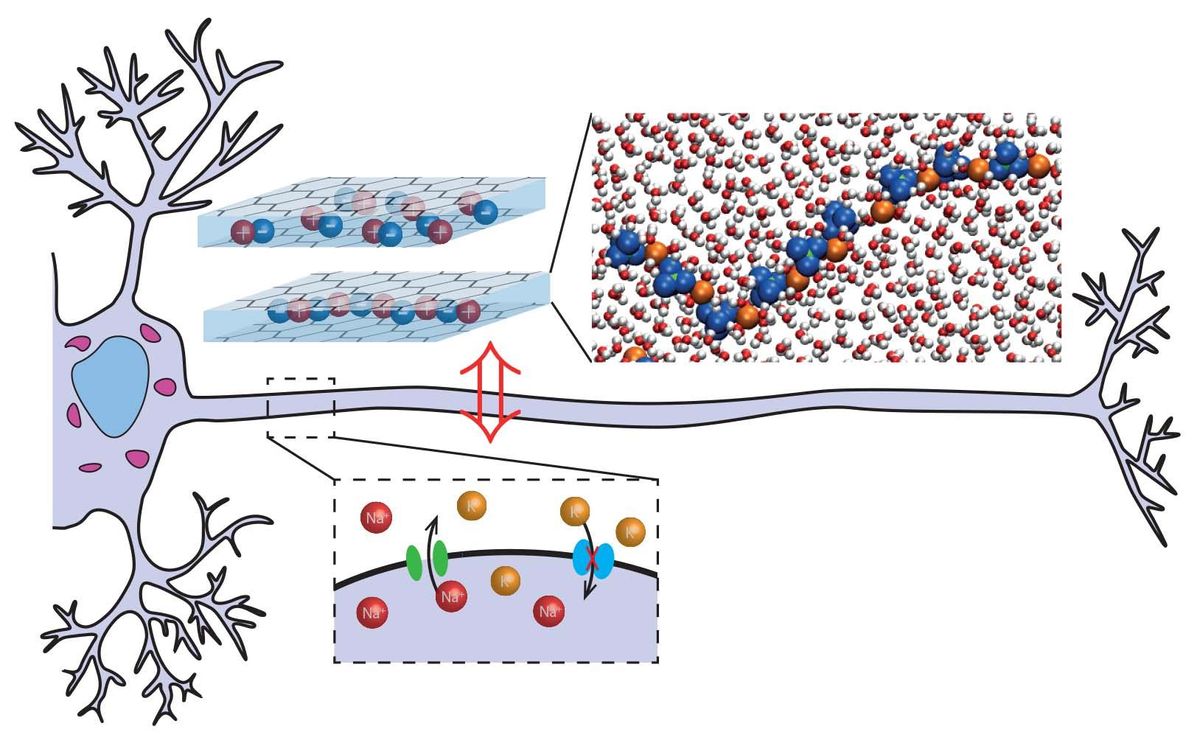Designing electronic systems that mimic the human brain, both in terms of energy use and ability to carry information, is a holy grail of scientific research. Whereas artificial intelligence has come a long way, these systems are still far from matching the brain's energy efficiency. A team of scientists from the ENS Laboratoire de Physique, Paris, believe the answer might lie in microfluidics.
"The human brain…needs only 20 watts [to function], essentially [as much as] a light bulb," says Paul Robin, one of the scientists on the study. "Computers need much more energy. Our idea is that maybe the reason why our brain is so much more efficient is that it uses ions and not electrons to function."
In a recent paper, they suggest that artificial neurons could be designed using ions rather than electrons to carry information. To demonstrate, they designed a device comprising a single layer of water molecules within extremely thin (less than a nanometer) graphene nanoslits. When an electric field is applied, the conduction properties of the water molecules start to show some "very weird" behavior, according to Robin. "These systems have some kind of memory," he say, "because inside them, ions actually assemble to bigger structures, which can be pairs of ions or even long strings of ions."
This is called the memristor effect, that is, these ion clusters retain some of the stimuli they have received in the past. Normally, when you apply a voltage, Robin explains, positive ions move in one direction and negative ions in the other. "But these structures do not react instantaneously to this electric field… [Instead, they] take some time before moving…[and] this gives the system some memory." If the stimulation is taken away, he adds, it will stay excitable for a few moments before going back to the initial state.
During his analytical computations, Robin noticed similarities between the equations he had written and those used in physiology to describe neurons. The graphene slits "are very reminiscent of ion channels [in the brain]…which are pores in the membranes of neurons that let—or do not let—ions pass through." Ion flows in neurons result in the emission of action potentials that allow them to communicate with each other in the brain. Using mathematical modeling, the researchers were able to demonstrate that the ion clusters reproduce the physical mechanism of emission of action potentials, and thus the transmission of information.
To create the proof of concept, the scientists used molecular dynamics simulations to create a prototype artificial neuron. In neuron physiology, Robin explains, there is an ensemble of pores, with each pore having the properties of a nanoslit in their device. "So my idea was to put several slits of graphene together to create this ensemble that looks like a neuron." Once this analogy was in place, he adds, it was just a matter of simulating several systems of instead of one.
"Theory and simulations are very nice, but at the end of the day, we are interested in concrete, practical results," Robin says, that is, to reproduce the same results in experiments. This work is ongoing, but there are some positive developments: "It seems that we do have some memory effects in experiments… And actually, the the memory effect is much stronger than we expected." In their paper, the memory was reported to be a few milliseconds, but experiments have shown this to be up to an hour.
There is no definitive proof yet that ion-based systems might be better than electron-based ones. "And so the first step," Robin says, "is to create a sort of iontronic system, and evaluate whether it is efficient or not." To do that, the scientists are looking into how these experimental results could be used to build an artificial neuron, or a small neural network, and then to see if such systems can implement simple learning algorithms.
Payal Dhar (she/they) is a freelance journalist on science, technology, and society. They write about AI, cybersecurity, surveillance, space, online communities, games, and any shiny new technology that catches their eye. You can find and DM Payal on Twitter (@payaldhar).



